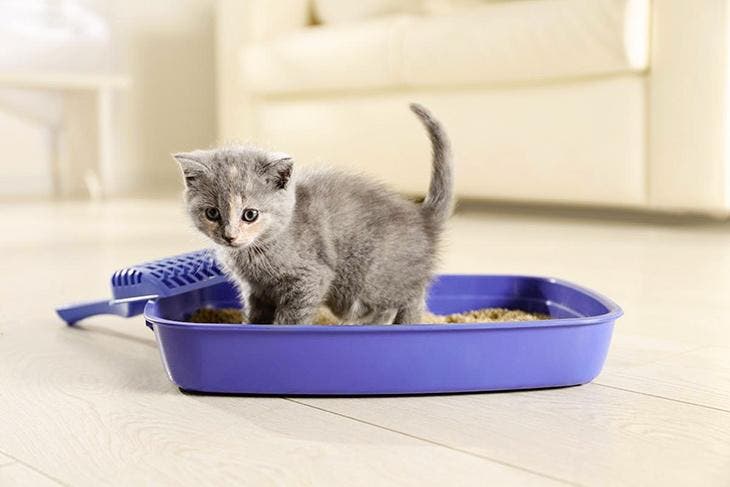Where to place the cat litter box?

No, your cat’s litter box doesn’t just go anywhere! It is important to choose a strategic location, a quiet place in the house, where there is little traffic and where your little feline can reach it comfortably at any time.
Here are the mistakes not to make:
- Avoid placing the litter box near noisy devices that could disturb your cat and discourage them from defecating there.
- Also, don’t consider placing the litter box in front of patio doors or glass doors, as the movement outside could noticeably scare your pet away and cause it to run away.
- Placing the litter box on the deck, garage, basement or any closet is also out of the question. The idea is to find a warm, discreet place, a little hidden but not too much. And above all, once installed, the litter box should not be moved! This is because your cat quickly gets used to this location and creates its own routine. The slightest change can cause him to lose his bearings and cause him to urinate anywhere at home!
Where to dispose of your cat’s litter box?
First of all, you should know that there are several models of litter boxes. Not all of the products on the market are the same and should not all be thrown away. Of course, as a cat owner, you know for a fact that the litter box is an integral part of your cat’s intimate grooming and that your cat’s hygiene must be impeccable. Ideally, the right frequency of litter cleaning is around once or twice a day. It is essential to keep it clean at all times, both to preserve your cat’s hygiene and to avoid all the foul smells that tend to spread around the house. Once the sand has been changed, all you have to do is put the dirty one in the dedicated bin.
We agree, it’s a tedious and tedious task, but a necessary one. However, it is not recommended to dump the litter directly into the bin. Apart from bad odours, germs and bacteria can easily spread through the air during the process. It is therefore better to put used litter in the bag dedicated to it before throwing it away. As you probably know, there are different models (silicone, clay, bentonite, etc.), although we strongly recommend that you use biodegradable bedding. Beware of silica litter, a non-recyclable and polluting material, which must be bagged and disposed of in a dry bin.
Recycling: what to do with used bedding?
It’s important to note that you can reuse most cat litters, but not all of them have the same uses. Unless they are biodegradable and compostable, some materials are unsuitable for compost and cannot even be used as fertilizer.
Recycling clay-based bedding
Clay litter can be used for construction, for example: when you clean the box, instead of throwing away the sand, you can recycle it in various ways.
- You can, for example, use it to repair certain cracked areas in the house. Just mix it with cement and voila! But be careful, it is not recommended to use sand that contains feces, it can contain dangerous parasites.
- Want to get rid of weeds in the garden? Although clay-based sand is not healthy for plants, you can recycle it to remove all the weeds that are ruining the landscape. Simply scatter them in the areas where these weeds grow. Obviously, again, only use sand that is free of feces or urine.
- Another little-known use: if your car has an oil leak, the trick is to use this type of litter to clean up the mess. Simply pour sand at the leak and it will do its work of absorption.
Do not dispose of silica-based litter in the trash
Learn that silica-based sands are not environmentally friendly. Such litter works differently than clumping. Its grains have small slits that can absorb liquid. They are small pores capable of absorbing 40% of their weight in water. Although different from clay, this material can also be recycled for a variety of uses. So you can also use this silica-based sand to repair a hole or fill a crack, by making it even more difficult to use.swaddling with cement. It will also help you get rid of weeds, but keep it away from your plants. Finally, being highly absorbent, silica sand will also help you eliminate a possible car oil leak.
Is my cat’s litter box compostable?
Composting is the process of collecting organic matter for processing into fertilizer. This is a common practice in terms of recycling and sustainable gardening. There is nothing more satisfying than giving organic waste a second life so that it naturally enriches the soil and boosts plant growth. But this eco-friendly gesture should not be done lightly. There are, of course, precautions to take before composting your furry friend’s litter!
Already keep in mind that making a compost requires some time and quite a bit of knowledge on the subject. If you have the slightest doubt, call on a specialist in the field to guide you through the process. It is imperative to use plant and biodegradable bedding for compost: such as flax, wheat, wood or cedar. On the other hand, mineral litter (as well as clay and silica-based sands) should absolutely not be put in the composter.
FYI
Sand containing feces is not recommended as a fertilizer for your garden. As we mentioned earlier, cat feces can contain germs that are toxic to humans. That is, you can use it as compost only in areas of the garden where the plants are not edible.





